MINI Hardtop 2 Door 2004 Owners Manual
Manufacturer: MINI, Model Year: 2004, Model line: Hardtop 2 Door, Model: MINI Hardtop 2 Door 2004Pages: 152, PDF Size: 1.41 MB
Page 91 of 152

89
OVERVIEW REPAIRSOPERATIONCONTROLS DATA INDEX
TIRE CODINGKnowing the tire code on the tire's sidewall
makes it easier for you to choose and iden-
tify the correct tires.Tire sizee.g. 205/45 R 17 84 V
Nominal width in mm
Cross-sectional
ratio in %
Radial belt construction
Rim diameter in inches
Load index,
not on ZR tires
Speed code letter,
in front of the R on ZR tires
Speed code letters:
Q= bis 105 mph / 160 km/h
T= up to 118 mph / 190 km/h
H= up to 131 mph / 210 km/h
V= up to 150 mph / 240 km/h
W= up to 167 mph / 270 km/hTire Identification NumberTires with DOT codes meet the guidelines
of the U.S. Department of Transportation. DOT code:
e.g. DOT xxxx xxx 3603
Manufacturer's code
for tire make
Tire size and
tire version
Tire age
Tire ageThe manufacturer of your MINI recom-
mends replacing all tires, including the
space-saver spare tire, regardless of actual
wear, after 6 years at the latest.
The date on which the tire was manufac-
tured is indicated by the code on the side-
wall:
DOT … 3603 indicates that the tire was
manufactured in Week 36 of the year 2003.Uniform Tire Quality GradingQuality grades can be found where applica-
ble on the tire sidewall between tread
shoulder and maximum section width.
For example:
DOT quality grades Treadwear 200
Traction AA A B C
Temperature A B C
All passenger car tires must conform
to Federal Safety Requirements in
addition to these grades.< Tread wearThe tread wear grade is a comparative rat-
ing based on the wear rate of the tire when
tested under controlled conditions on a
specified government test course.
For example, a tire graded 150 would wear
one and one-half, 1 γ times as well on the
government course as a tire graded 100.
The relative performance of tires depends
upon the actual conditions of their use,
however, and may depart significantly
from the norm due to variations in driving
habits, service practices and differences in
road characteristics and climate.
Page 92 of 152

90
TIRE CODINGTraction The traction grades, from highest to lowest,
are AA, A, B, and C.
Those grades represent the tire's ability to
stop on wet pavement as measured under
controlled conditions on specified govern-
ment test surfaces of asphalt and concrete.
A tire marked C may have poor traction per-
formance.
The traction grade assigned to this
tire is based on straight-ahead brak-
ing traction tests, and does not include
acceleration, cornering, hydroplaning, or
peak traction characteristics.
to the generation of heat and its ability to
dissipate heat when tested under con-
trolled conditions on a specified indoor lab-
oratory test wheel.
Sustained high temperature can cause the
material of the tire to degenerate and
reduce tire life, and excessive temperature
can lead to a sudden flat tire. The grade C
corresponds to a level of performance
which all passenger car tires must meet
under the Federal Motor Vehicle Safety
Standard No. 109. Grades B and A represent
higher levels of performance on the labora-
tory test wheel than the minimum required
by law.
The temperature grade for this tire is
established for a tire that is properly
inflated and not overloaded. Excessive
speed, underinflation, or excessive loading,
either separately or in combination, can
cause heat buildup and possible tire fail-
ure.
the side of the tire, refer to page 93.M+SWinter and all-season tires.
These have better winter performance
properties than summer tires.
Page 93 of 152

91
OVERVIEW REPAIRSOPERATIONCONTROLS DATA INDEX
TIRE CONDITION Tire tread Inspect your tires frequently for tread wear,
signs of damage and for foreign objects
lodged in the tread. Check the tread depth.
The tread depth should not fall below
1/8 in / 3 mm.
Below 1/8 in / 3 mm tread pattern depth,
there is an increased risk of hydroplaning,
even at relatively moderate speeds and
with only small amounts of water on the
road.
Below a tread depth of 1/6 in / 4 mm, win-
ter tires display a perceptible decrease in
their ability to cope with winter driving
conditions, and should be replaced in the
interest of safety.Wear indicators in the tread-groove base,
arrow, are spread around the circumfer-
ence of the tire and are marked on the side
wall of the tire with TWI, Tread Wear Indi-
cator. The indicators in the tread indicate at
1/16 in / 1.6 mm tread depth that the
legally permitted wear limit has been
reached.
Tire damage
Unusual vibrations while driving can
indicate tire damage or other dam-
age to the vehicle. This may be caused, for
example, by driving over a curb. This is also
true for abnormalities in the vehicle's han-
dling characteristics, such as a pronounced
tendency to pull to the left or right. Should
this occur, respond by immediately reduc-
ing your speed. Proceed carefully to the
nearest MINI Dealer or professional tire
center, or have the vehicle towed there to
have its wheels and/or tires inspected or
controlled. Tire damage – up to and includ-
ing blowouts – can endanger the lives of
both the vehicle occupants and other road
users.<
Page 94 of 152
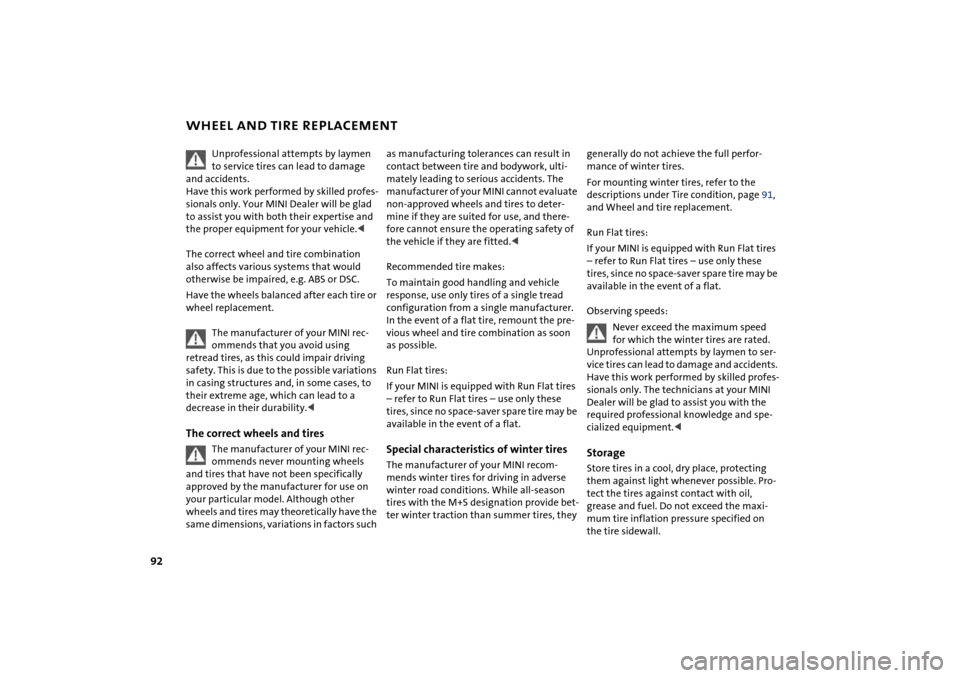
92
WHEEL AND TIRE REPLACEMENT
Unprofessional attempts by laymen
to service tires can lead to damage
and accidents.
Have this work performed by skilled profes-
sionals only. Your MINI Dealer will be glad
to assist you with both their expertise and
the proper equipment for your vehicle.<
The correct wheel and tire combination
also affects various systems that would
otherwise be impaired, e.g. ABS or DSC.
Have the wheels balanced after each tire or
wheel replacement.
The manufacturer of your MINI rec-
ommends that you avoid using
retread tires, as this could impair driving
safety. This is due to the possible variations
in casing structures and, in some cases, to
their extreme age, which can lead to a
decrease in their durability.<
The correct wheels and tires
The manufacturer of your MINI rec-
ommends never mounting wheels
and tires that have not been specifically
approved by the manufacturer for use on
your particular model. Although other
wheels and tires may theoretically have the
same dimensions, variations in factors such
as manufacturing tolerances can result in
contact between tire and bodywork, ulti-
mately leading to serious accidents. The
manufacturer of your MINI cannot evaluate
non-approved wheels and tires to deter-
mine if they are suited for use, and there-
fore cannot ensure the operating safety of
the vehicle if they are fitted.<
Recommended tire makes:
To maintain good handling and vehicle
response, use only tires of a single tread
configuration from a single manufacturer.
In the event of a flat tire, remount the pre-
vious wheel and tire combination as soon
as possible.
Run Flat tires:
If your MINI is equipped with Run Flat tires
– refer to Run Flat tires – use only these
tires, since no space-saver spare tire may be
available in the event of a flat. Special characteristics of winter tires The manufacturer of your MINI recom-
mends winter tires for driving in adverse
winter road conditions. While all-season
tires with the M+S designation provide bet-
ter winter traction than summer tires, they generally do not achieve the full perfor-
mance of winter tires.
For mounting winter tires, refer to the
descriptions under Tire condition, page 91,
and Wheel and tire replacement.
Run Flat tires:
If your MINI is equipped with Run Flat tires
– refer to Run Flat tires – use only these
tires, since no space-saver spare tire may be
available in the event of a flat.
Observing speeds:
Never exceed the maximum speed
for which the winter tires are rated.
Unprofessional attempts by laymen to ser-
vice tires can lead to damage and accidents.
Have this work performed by skilled profes-
sionals only. The technicians at your MINI
Dealer will be glad to assist you with the
required professional knowledge and spe-
cialized equipment.<
StorageStore tires in a cool, dry place, protecting
them against light whenever possible. Pro-
tect the tires against contact with oil,
grease and fuel. Do not exceed the maxi-
mum tire inflation pressure specified on
the tire sidewall.
Page 95 of 152

93
OVERVIEW REPAIRSOPERATIONCONTROLS DATA INDEX
RUN FLAT TIRES
*
You will recognize Run Flat tires by a circu-
lar symbol containing the letters RSC on
the side of the tire. Run Flat tires consist of
self-contained tires and special rims. The
tire reinforcement ensures that driving
remains possible to a restricted degree in
the event of a pressure drop or even a flat
tire.
When mounting or replacing summer
Run Flat tires with winter tires, or vice
versa, use Run Flat tires again since no
space-saver spare tire is available in the
event of a flat. In this event, the manufac-
turer of your MINI recommends consulting
your MINI Dealer. Your MINI Dealer has the
necessary special equipment and expertise
for handling Run Flat tires.<
Continuing driving with a damaged
tire Depending on the load, you can continue
driving with Run Flat tires at a maximum
speed of 50 mph / 80 km/h.
If there is a total loss of tire inflation pres-
sure, 0 psi / 0 kPa, or obvious tire damage,
you can gauge the mileage for continued
driving on the basis of the following indica-
tions:
>With a light load:
1 to 2 persons without luggage:
approx. 155 miles / 250 km
>With a medium load:
2 persons, full cargo area, or
4 persons without luggage:
approx. 95 miles / 150 km
>With a full load:
4 persons or more, full cargo:
approx. 30 miles / 50 km.Drive cautiously. Do not exceed a
speed of 50 mph / 80 km/h. In case of
tire pressure loss you must expect changes
in vehicle handling such as lower track sta-
bility during braking, longer braking dis-
tances and changes in self-steering proper-
ties when close to the handling limit.
For safety reasons, the manufacturer of
your MINI recommends not having dam-
aged Run Flat tires repaired. In this case,
consult your MINI dealer.<
Tire change setYour MINI is additionally equipped with a
tire change set. This is located in the MINI
COOPER in the cargo area under the floor
mat.
In the MINI COOPER S the tire change set is
located in a separate bag which is attached
to the eyelets on the cargo area floor by
means of tie-down straps.
When changing a tire, always observe the
safety measures on page 116, and follow
the procedure described on page 117 ff.
In case of a flat tire, the tire change
set is not needed, since your MINI has
Run Flat tires.<
Page 96 of 152

94
SNOW CHAINS
*
Only certain types of snow chains have
been tested by the manufacturer of your
MINI, classified as road-safe and approved.
Contact your MINI Dealer for more details.
The manufacturer of your MINI recom-
mends that you use only these approved
fine-link snow chains. Their use is only per-
mitted in pairs on the front wheels on win-
ter tires of the following types:
>175/65 R 15 M+S
>175/60 R 16 M+S.
When fitting, comply with the manufac-
turer's instructions. With chains, do not
exceed a speed of 30 mph / 50 km/h.
Do not initialize the Flat Tire Monitor
after attaching snow chains to the
tires.
When driving with snow chains, it can be
helpful to switch off the ASC or DSC for a
brief period, refer to pages 59, 60.<
Page 97 of 152
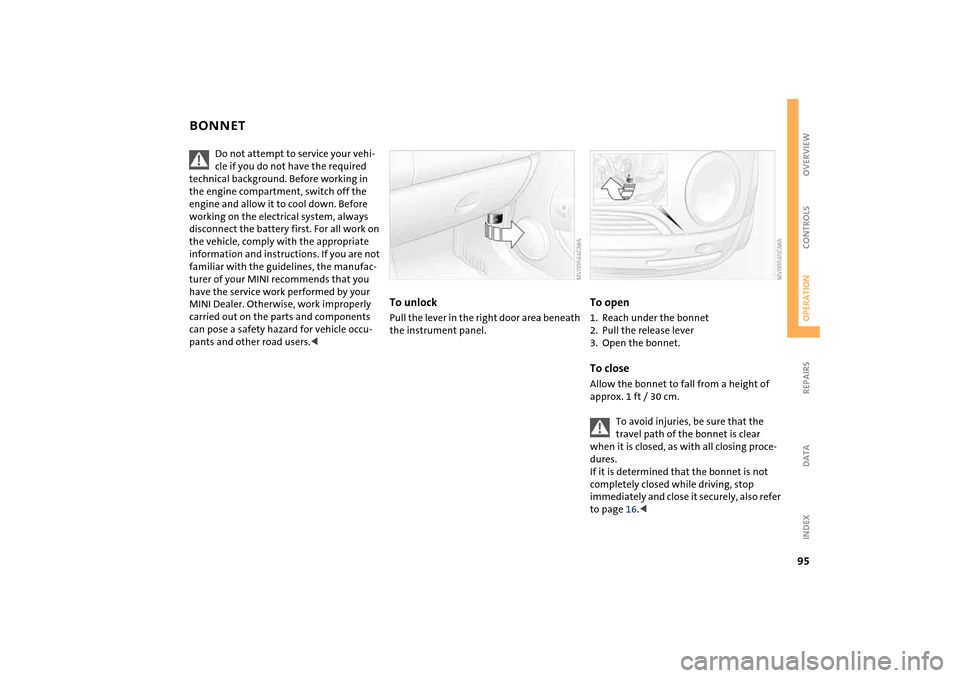
95
OVERVIEW REPAIRSOPERATIONCONTROLS DATA INDEX
BONNET
Do not attempt to service your vehi-
cle if you do not have the required
technical background. Before working in
the engine compartment, switch off the
engine and allow it to cool down. Before
working on the electrical system, always
disconnect the battery first. For all work on
the vehicle, comply with the appropriate
information and instructions. If you are not
familiar with the guidelines, the manufac-
turer of your MINI recommends that you
have the service work performed by your
MINI Dealer. Otherwise, work improperly
carried out on the parts and components
can pose a safety hazard for vehicle occu-
pants and other road users.<
To unlockPull the lever in the right door area beneath
the instrument panel.
To open1. Reach under the bonnet
2. Pull the release lever
3. Open the bonnet.To closeAllow the bonnet to fall from a height of
approx. 1 ft / 30 cm.
To avoid injuries, be sure that the
travel path of the bonnet is clear
when it is closed, as with all closing proce-
dures.
If it is determined that the bonnet is not
completely closed while driving, stop
immediately and close it securely, also refer
to page 16.<
Page 98 of 152
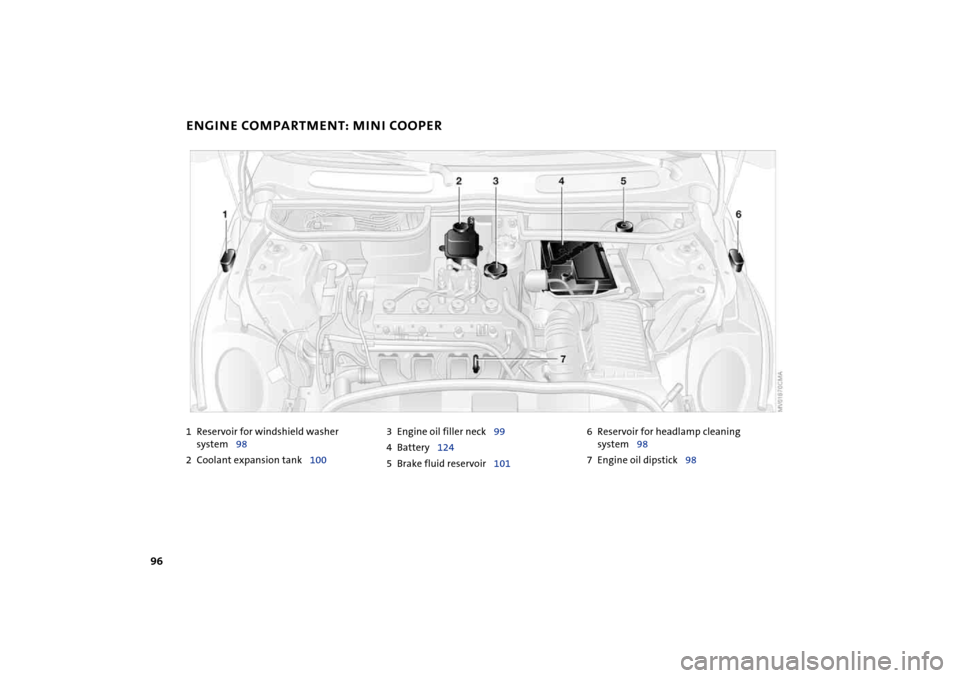
96
ENGINE COMPARTMENT: MINI COOPER1Reservoir for windshield washer
system98
2Coolant expansion tank1003Engine oil filler neck99
4Battery124
5Brake fluid reservoir1016Reservoir for headlamp cleaning
system98
7Engine oil dipstick98
Page 99 of 152
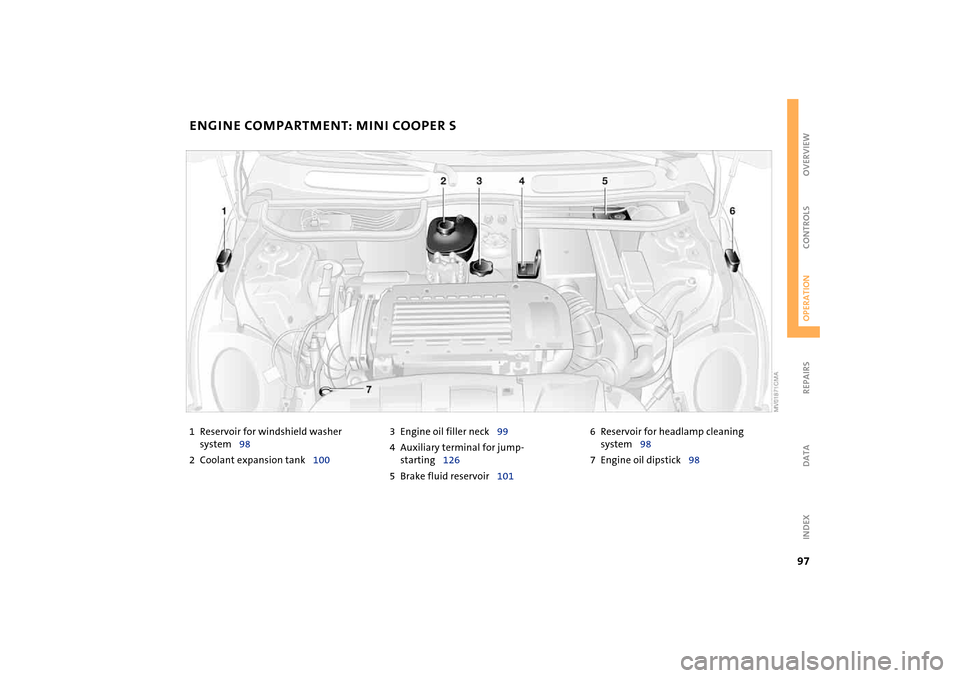
97
OVERVIEW REPAIRSOPERATIONCONTROLS DATA INDEX
ENGINE COMPARTMENT: MINI COOPER S1Reservoir for windshield washer
system98
2Coolant expansion tank1003Engine oil filler neck99
4Auxiliary terminal for jump-
starting126
5Brake fluid reservoir1016Reservoir for headlamp cleaning
system98
7Engine oil dipstick98
Page 100 of 152
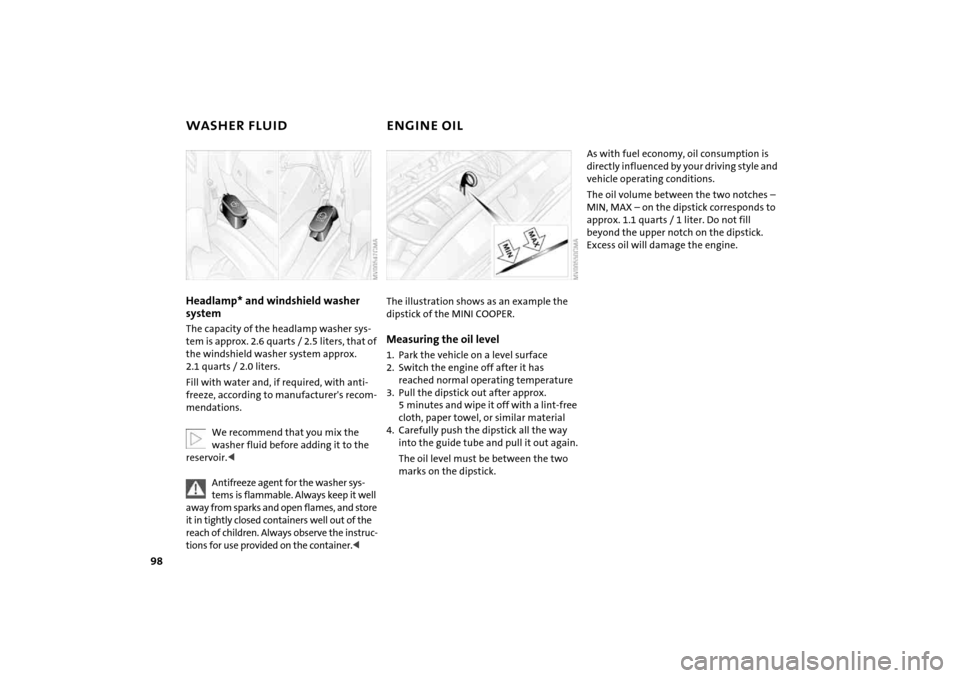
98
WASHER FLUID ENGINE OILHeadlamp* and windshield washer
system The capacity of the headlamp washer sys-
tem is approx. 2.6 quarts / 2.5 liters, that of
the windshield washer system approx.
2.1 quarts / 2.0 liters.
Fill with water and, if required, with anti-
freeze, according to manufacturer's recom-
mendations.
We recommend that you mix the
washer fluid before adding it to the
reservoir.<
Antifreeze agent for the washer sys-
tems is flammable. Always keep it well
away from sparks and open flames, and store
it in tightly closed containers well out of the
reach of children. Always observe the instruc-
tions for use provided on the container.<
The illustration shows as an example the
dipstick of the MINI COOPER.Measuring the oil level1. Park the vehicle on a level surface
2. Switch the engine off after it has
reached normal operating temperature
3. Pull the dipstick out after approx.
5 minutes and wipe it off with a lint-free
cloth, paper towel, or similar material
4. Carefully push the dipstick all the way
into the guide tube and pull it out again.
The oil level must be between the two
marks on the dipstick.
As with fuel economy, oil consumption is
directly influenced by your driving style and
vehicle operating conditions.
The oil volume between the two notches –
MIN, MAX – on the dipstick corresponds to
approx. 1.1 quarts / 1 liter. Do not fill
beyond the upper notch on the dipstick.
Excess oil will damage the engine.